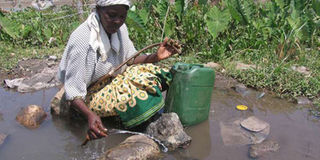How dry taps dictate where city residents live and plan their day

A woman draws water from a broken pipe in Nairobi's Komarock estate. PHOTO | JOSEPH KANYI
What you need to know:
- According to a new study by Athi Water Services, the current supply in Nairobi is far below the daily demands of its 3.8 million residents.
- The water demand for the city and its environs is estimated at 700,000 cubic metres a day.
Rebecca Kariuki moved into her new apartment in Pangani after her new landlord assured her that she will never have any water problems.
Come moving day, and the first thing Ms Kariuki noticed was a hand-cart outside the gate, stacked with yellow 20-litre plastic containers.
Then, on her way up the stairs to her second floor apartment, she saw many jerry cans on some of her neighbours’ balconies.
She didn’t think much of it, until a few days later when she turned her kitchen tap and not a single drop came out. Then it all made sense.
“Of course the landlord had lied to me,” she told the Nation. “This place barely has water. It was too costly to start looking for another house so soon. So I bought my own reserve water containers and adjusted.”
Ms Kariuki is one of the 1.3 million Nairobi residents who are “either under served or receive no water” through the government supply systems.
According to a new study by Athi Water Services, the current supply in Nairobi is far below the daily demands of its 3.8 million residents.
The water demand for the city and its environs is estimated at 700,000 cubic metres a day.
The crisis comes a year after the gazettement of new tariffs that saw the cost of water go up by almost 90 per cent.
Water and Irrigation Cabinet Secretary Eugene Wamalwa pointed out in a recent interview that the current daily supply is just over 500,000 cubic metres, a significant gap, considering the rapidly rising population.
“We need to come up with solutions to bridge this gap, either through proper legislation or encouraging private investors to set up more water utilities,” said Mr Wamalwa.
Mr Maxwell Kezengwa, unlike Ms Kariuki, knew what he was getting into when he decided to rent an apartment in the populous Highrise Estate on Mbagathi Way some two years ago.
RESERVE TANK
“The water situation here is terrible. As we speak, there has not been water in Highrise for a month and two weeks, and when it comes, it is a trickle once a week or in two weeks,” he said.
But Mr Kezengwa says he is one of those few residents who have been lucky enough not to bear the brunt of the shortage.
“My landlord had installed a 2,000 litre reserve tank that I have been using alone, and this has been very helpful during the shortage,” he said.
His neighbour, Mr Collins Omondi is not so lucky, and he blames what he refers to as “water cartels” for most of the water problems in the area.
Mr Omondi lamented the possibility that he may even end up spending more on water than on rent, if the situation does not change.
“These water vendors have been taking advantage of the situation and selling water to us at exorbitant prices. A 20-litre jerry can of water usually goes for about Sh70 to Sh100. This is unsustainable,” he said.
Water shortages have become a significant factor in how Nairobians plan their lives, from deciding where to live and even when to do house chores that require water.
The most affected areas are towards the south and west, including but not limited to Lang’ata, Highrise, South C, South B, Nairobi West, Madaraka and Ngumo.
Some landlords, in order to attract tenants, have had to invest heavily in water supply to cover for the deficiencies of the county supply system.
Many resident have had to deal with recurrent shortages without complaining because it is too costly to live anywhere else.
In surrounding areas, such as Kinoo and Kikuyu in Kiambu County, most landlords have drilled boreholes to supply water to tenants as county water is largely non-existent.
Mr Kezengwa, the resident from Highrise, says he is looking to move to new neighbourhood without water problems.
“But many areas with reliable water supply are those high-end estates that are too expensive, so many of us don’t really have much of a choice,” he said.





